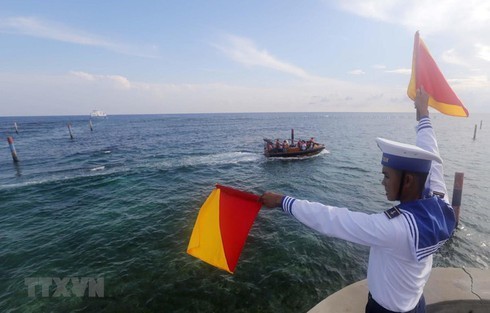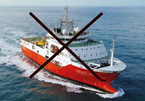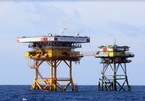 |
|
A Vietnamese naval soldier in Ladd Reef of Vietnam's Spratly archipelago
|
“Grey zone” is a term given to the state of being between war and peace, without a premise for a conflict and other countries have no reason to make a military intervention.
Using the tactic, a country can deploy military forces under the cover of civil forces in combination with psychological, judicial, and communications tactics to turn an undisputed are into a disputed area.
Analysis of specific activities
Analyzing China’s bold activities to intensify tensions in the East Sea, it’s obvious that China has deployed and adjusted its “grey zone” tactic in different periods.
First, it has transformed and militarized commercial and fishing boats. China has a big fleet of modern maritime surveillance and fisheries law enforcement boats. Satellite images show that China has ever sent 200 to 300 fishing vessels to Subi Reef and Mischief Reef in Vietnam’s Spratly archipelago.
They have aggressively prevented fishing boats of other countries from legally operating in their own sovereign waters.
They are equipped with 30 mm and 76 mm cannons to dominate maritime disputes, and are able to enter areas and carry out missions that naval ships would not be allowed to do in another country’s waters. In many cases, the vessels themselves become weapons, ramming other ships. The tactic has raised great concerns in the region.
Beijing called the clashes normal maritime accidents between fishing boats. Observers say that by disguising this maritime militia, Chinese ships can repeatedly clash with foreign ships, which China argues are operating within China’s “9-dash line” which encompasses 80% of the East Sea.
In 2014, China sent the Haiyang-981 oil rig to a location within Vietnam’s maritime area. From July to October this year, China’s Haiyang Yizhi 8 survey vessel encroached on Vietnam’s Exclusive Economic Zone and continental shelf near the Tu Chinh reef (Vanguard Bank).
China has deployed maritime militia and coastguard forces to hamper other countries’ petroleum exploration and fishing activities.
China has established new illegal military bases in the East Sea to consolidate its influence. Part of China’s “grey zone” tactic is to enhance communications activities to introduce specious historical evidence, send scholars abroad to talk about its sovereignty, and publish articles in favor of Chinese views.
Negative impacts on regional peace, security
Other countries and the international public have never acknowledged China’s baseless 9-dash line claim. The US State Department report “A Free and Open Indo-Pacific: Advancing a Shared Vision” released on November 4th says China’s sovereignty in the East Sea based on the 9-dash line is baseless and illegitimate.
In 2016 in a Philippine suit against China, the Permanent Court of Arbitration delivered the verdict that China has no legal footing or valid historic claim. Nonetheless, China has continued to claim sovereignty over other countries’ seas and turn undisputed maritime areas into disputed areas.
China’s grey zone tactic has intensified confrontation in the East Sea and negatively impacted regional peace and security. It demands joint action and shared respect for international law, particularly the 1982 UNCLOS, by countries worldwide to ensure a just order in the East Sea. VOV

China is resorting to new forms of bullying in the East Sea
Less is heard these days about China’s massive terraforming operations in the East Sea, which not long ago exercised neighbours as well as the United States.

Rule of law: Solution for peace in the East Sea
China, Vietnam, Malaysia, the Philippines and Brunei all approved the United Nations Convention on the Law of the Sea 1982 (UNCLOS). This Convention prohibits the use of and threat of using force in the settlement of disputes at sea.
 Experts on the East Sea say China’s “grey zone” strategy provokes tension in order to control most of the East Sea.
Experts on the East Sea say China’s “grey zone” strategy provokes tension in order to control most of the East Sea.